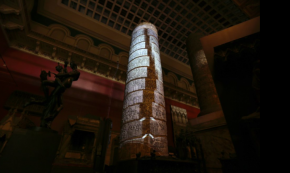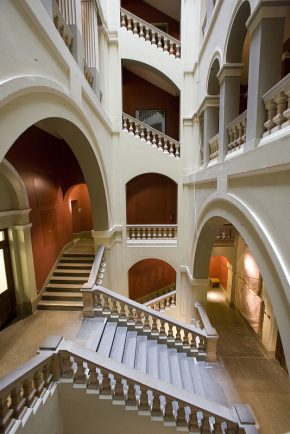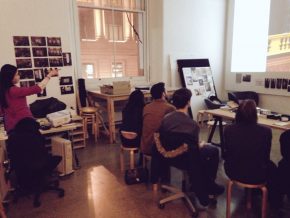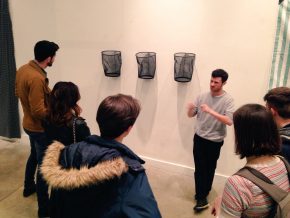Good Friday. It’s 06.27 PM. A large security guard stands in front of me. He switches on a tiny torch to do the bag search at the main entrance of the museum. I look at him restlessly; I don’t want to be late. We swap smiles and with a welcoming reception I walk in straight line under the main dome towards the shop. Above my head I contemplate once again the Chihuly’s enormous glass Chandelier. This evening it seems to be as gleaming as the sunshine. Although the museum is not very crowded today I can notice the hustle and bustle around me. Every Friday the museum shuts its doors later and the festive atmosphere spreads all over the place. Some people are having drinks with a light-hearted chat sitting around the hall. Others stand still, amazed by the majesty of the building and its collections.
There they are! Jamie and Yiyun are waiting right outside the main museum shop, on the left hand side and next to a signage stating “Open Studios”[i]. I wave at them and introduce myself. I came here to help.
As a VE Volunteer, I have to welcome visitors and to offer information about the museum layout, collections and gallery/visitors policy. Together with an outstanding team every Wednesday morning we promote V&A exhibitions and events dealing with visitor comments and helping them to get the most of their visit. However, this evening something else is going on. I came to collaborate with the Learning Department distributing wristbands to visitors and also helping the artists-in-residence[ii] to walk everyone to the studio.
 Last week I had the opportunity to host an installation at the gallery 46A of the Cast Courts made by Samsung Korean Digital Art Resident Yiyun Kang[iii]. I like to engage with the museum in multiple forms and I am a fervent admirer of how inclusive and participatory is the Learning Department of the V&A. Perhaps one of the things I enjoy most it’s the possibility for collaboration with other departments with the delivery of events so when the opportunity arouse I couldn’t say no. This was an invaluable occasion to explore, on the one hand, the role played by the museum in regards to research and contemporary practise and, on the other hand, to share thoughts with colleagues and visitors about Yiyun’s projection mapping installation. Many mixed feelings came to the fore. A timeless immersion was created by Yiyun to discover new architectural forms with her digital projections onto some of the casts, a truly ephemeral experience of the space uplifted only by the music it was played.
Last week I had the opportunity to host an installation at the gallery 46A of the Cast Courts made by Samsung Korean Digital Art Resident Yiyun Kang[iii]. I like to engage with the museum in multiple forms and I am a fervent admirer of how inclusive and participatory is the Learning Department of the V&A. Perhaps one of the things I enjoy most it’s the possibility for collaboration with other departments with the delivery of events so when the opportunity arouse I couldn’t say no. This was an invaluable occasion to explore, on the one hand, the role played by the museum in regards to research and contemporary practise and, on the other hand, to share thoughts with colleagues and visitors about Yiyun’s projection mapping installation. Many mixed feelings came to the fore. A timeless immersion was created by Yiyun to discover new architectural forms with her digital projections onto some of the casts, a truly ephemeral experience of the space uplifted only by the music it was played.
Some days later a new opportunity came up to help with the Open Studios and when I signed in to assist in the event I couldn’t imagine what was waiting for me today. The tour was scheduled at 7 PM and ten minutes before starting few people show up. I decide to walk around and to promote the opening of the studios inviting more visitors to join. We end up having a decent group of curious visitors and we escort them through the restricted areas of the museum towards the Sackler Centre[iv].
 Designed by Softroom, which also designed the V&A’s Members Room and the Jameel Gallery, the Sackler Centre is currently close to the general public due to the construction of the Exhibition road building. Winner of a prestigious RIBA London award, the Centre was designed to accommodate informal and self-directed learning as well as formal education and is expected to reopen in 2017[v]. At present, only special events like the Open Studios offer the opportunity to get into the artists-in-residence workshops and to admire one of the greatest hidden treasures of the museum, the Henry Cole Wing[vi] Escher-esque grand staircase that gives access to the Sackler Centre. It’s truly a piece of art rarely open to the public and architecturally, my new favourite part of the building.
Designed by Softroom, which also designed the V&A’s Members Room and the Jameel Gallery, the Sackler Centre is currently close to the general public due to the construction of the Exhibition road building. Winner of a prestigious RIBA London award, the Centre was designed to accommodate informal and self-directed learning as well as formal education and is expected to reopen in 2017[v]. At present, only special events like the Open Studios offer the opportunity to get into the artists-in-residence workshops and to admire one of the greatest hidden treasures of the museum, the Henry Cole Wing[vi] Escher-esque grand staircase that gives access to the Sackler Centre. It’s truly a piece of art rarely open to the public and architecturally, my new favourite part of the building.
Yiyun starts her presentation talking about her research with the V&A and her past exhibitions both nationally and internationally. I steadily observe how delighted the audience seems to be looking at the projection screen and wondering how the creative process of mapping material surfaces with video projection is. I look at her absorbed by her talent: How does her work affect my optical approach to her immaterial imaginary? Where does digital artwork remain after having been displayed? Is this the only art form able to create a real event based on the uniqueness of an unrepeatable experience? I get lost in thought but I guess I am not the only one. Fortunately the artist is very pleased to answer questions and an informal conversation occurs between Yiyun and the attendees.
Next door, Exhibition Road Digital Resident Jamie Jenkinson[vii] is ready to open his studio to the group. Both Yiyun and Jamie don’t look very nervous. They have done this several times already and they usually give public speeches lecturing at university or at private views for their exhibitions. I don’t know Jamie so I don’t really know what to expect. He is a video artist, although he prefers to call himself a maker. He explores different means to address his interest in the experimental production of the image. He is not that interested on the narratives as much as on the technical research of the objects. The studio is divided in two parts, a small room with a digital lab and computers and a second one reserved only for display with a light slope towards the end. He starts touring the group from one artwork to the other: installations, sculptures and video projections are exhibited along the room. His non-approach to narratives gives free access to interpretation, empowering the public and releasing the artwork from aesthetic autonomy. His approach kind of reminds me Guy Debord’s slogan back right in the beginning of the golden age of Situationist discourse: “We will not lead; we will only detonate”[viii]. Some of his works are difficult to look at due to the challenging optical tricks he plays with. I am mesmerized by the deep research he displays with just few pieces and the relationship I find between some of them and the metaphysical matter of time. Where do we place historical time when the artwork is in an endless movement? His work seems to be the time used by our thoughts and not the time of the text (where everything is fixed and exposed to interpretation), a time where everything changes and nothing stands still. It is a chaotic time, it has not measure; perhaps it is the only time that creativity tolerates, the time of research.
I don’t know what time it is but I have to walk visitors back to the cafeteria. Jamie and Yiyun were so wonderful that I can hardly process all the thoughts and emotions thriving right on the top of my head upside down to the very end of my toes’ tips. Having the chance to meet and talk face to face with these two artists-in-residence is one of the most immersive experiences I ever had as a visitor in a museum; a truly participatory experience where the public creates through their active contribution of ideas, sharing their thoughts and connecting with each other around the content given by first-class emerging artists from all over the world.
Yiyun and Jamie just finished their residency this month but new artists[ix] are coming soon to contribute to the museum with their talent and with them, new opportunities to freely assist to the Open Studios will pop up. If you don’t want to miss this incredible experience, check the notes below for further information and save the dates[x]. It is worth coming over.
Notes on Further Information and Resources
[i] Museum Residency Programme: http://www.vam.ac.uk/page/m/museum-residency-programme/
[ii] Information on the last open studios of Yiyun Kang and Jamie Jenkinson:
[iii] Samsung Korean Digital Art Resident: Yiyun Kang http://www.vam.ac.uk/content/articles/s/samsung-korean-digital-art-resident-yiyun-kang/
[iv] Sackler Centre for arts education: design & build http://www.vam.ac.uk/content/articles/s/sackler-centre-for-arts-education-design-and-build/
[v] About the Exhibition road buiding project: http://www.vam.ac.uk/content/articles/a/futureplan-exhibition-road-building-project/
[vi] Henry Cole Wing: http://www.vam.ac.uk/users/node/1375
[vii] Exhibition Road Digital Resident: Jamie Jenkinson http://www.vam.ac.uk/content/articles/e/exhibition-road-digital-resident-jamie-jenkinson/
[viii] Guy Debord, slogan in ”On the Passage of a Few People Through a Rather Brief Moment in Time: The Situationist International, 1957-1972” – quoted in The New York Times, 27th December 1989 http://www.nytimes.com/1989/12/27/arts/review-art-a-show-of-the-anti-movement-movement.html?pagewanted=all
[ix] These are the profiles of the new artists-in-residence of the V&A:
- Exhibition Road Engineering Resident: Julian Melchiorri http://www.vam.ac.uk/content/articles/e/exhibition-road-engineering-resident-julian-melchiorri/
- Goethe V&A Photography Resident: Helmut Völter: http://www.vam.ac.uk/content/articles/g/goethe-v-and-a-photography-resident-helmut-volter/
- V&A Finnish Institute in London Ceramics Resident: Pauliina Pöllänen: http://www.vam.ac.uk/content/articles/c/ceramics-resident-pauliina-pollanen/
[x] Please find the dates of the next Open Studios here below:
- For Pauliina Pöllänen Open Studios: https://shop.vam.ac.uk/whatson/index/view/id/2473/event/Pauliina-P–ll–nen–V-A-Finnish-Institute-in-London-Ceramics-Resident/dt/2016-04-20/free/1
- For Helmut Völter Open Studios: https://shop.vam.ac.uk/whatson/index/view/id/2429/event/Helmut-V–lter–Goethe-V-A-Photography-Resident/dt/2016-04-20/free/1
- For Julian Melchiorri Open Studios: https://shop.vam.ac.uk/whatson/index/view/id/2431/event/Julian-Melchiorri–Exhibition-Road-Engineering-Resident/dt/2018-05-27/free/1.






Great information. Lucky me I found your blog by
chance (stumbleupon). I’ve book marked it for later!